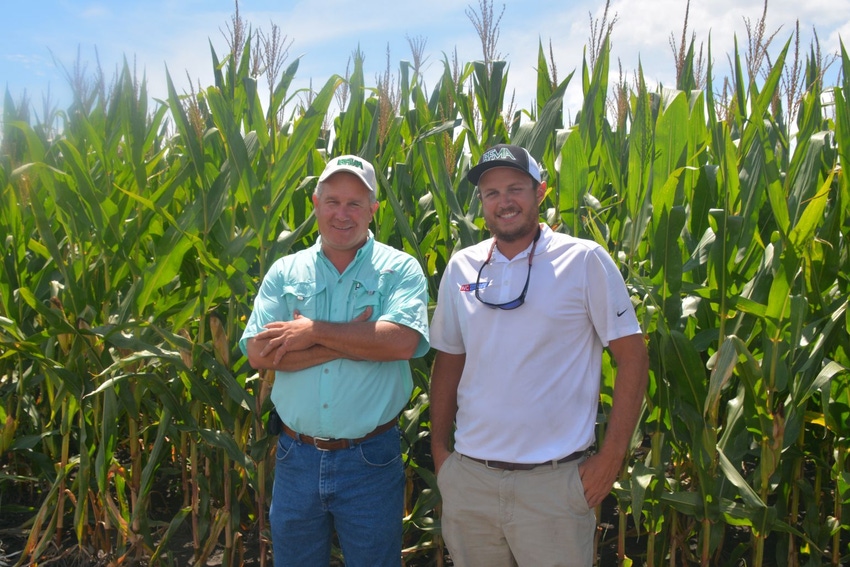
Irrigation alone won’t give you 300-bushel corn yields. Taking care of the crop every step of the way is a must for achieving top yields, which includes everything from seed treatments to proper planter adjustment to good fungicide management.
At this year’s Blacklands Farm Managers Tour held Aug. 2 at Green Valley Farms in Columbia, N.C., Yadkin County farmer Kevin Matthews outlined the steps his family takes to achieve 300 bushels per acre corn yields. Matthews Family Farms garnered the highest yield in the 2016 North Carolina Corn Yield Contest with a yield of 320.20 bushels per acre on irrigated ground.
Matthews emphasized the importance of irrigation in reaching top yields, but he made it clear that you have to do other things right as well.
“You’ll never get the success that you think you should just because you have irrigation. Irrigation is not a silver bullet, but it sure provides a lot of power to get that bullet going,” Matthews said in his presentation after lunch at the Blacklands tour.
Unless it’s raining, Matthews will run his subsurface drip irrigation system 7 days a week, 24 hours a day. “We don’t have a real good water holding capacity,” he explains.
His soils in the Yadkin River Valley range from red bottom clay to dark blackland river bottom to white beach sand. “We have a little bit of everything. Our dealer designed our subsurface drip irrigation system to match the soil type, so if I have a sandy area, I’ll really go with a high level of water. It takes a lot of water to keep that crop sustainable,” Matthews said.
The Yadkin County farmer notes that his house is near the river bottom of the Yadkin River and the soil there is 18 feet deep of pure white beach sand. “We’re actually growing 260 bushel yields there with irrigation. Without irrigation, we’d be getting 60 bushels, if anything,” Matthews said.
Matthews laid out his corn irrigation schedule:
V2-V3 - If there is no rain, he will irrigate more than 1 inch.
V3-V4 - Begins routine weekly irrigation.
V5-V6 - Doesn’t get behind with routine irrigation.
V6-V8 - Rapid growth is occurring so water demand is increasing.
V8-V11 - Water demand is particularly high.
V11-V16 - Keep soil surface humid.
VT-R2 – Daily irrigation is needed to avoid stress.
R4 – Water demand is decreasing.
Matthews says the bottom line is to avoid stress to the corn plants throughout the growing season.
In his comments, Matthews also emphasized the importance of fungicides.
“We’re in that river valley We have about 12 to 14 hours of leaf wetness every day so it’s not if you’re going to spray a fungicide, it’s when you’re going to spray. A lot of the time on high yielding corn, we may have to put three applications on just to keep the Southern rust away and the gray leaf spot down. It can get really ugly,” he said.
When he is aiming for 300 bushel per acre corn, Matthews will make his first fungicide application at V16, make another application at R3, R4 and if needed, make a third application at R5, if Southern rust is coming in. “We use a cheap triazole or generic that third time to save money,” he said.
At V16-VT, he makes an application of Headline AMP, Cryptomyte and a pyrethroid. At R3-R4, he makes another application of Headline AMP and Cyptomyte.
Also, at planting, it is vital to keep the planter perfectly level. “You can’t blame your failures on the seed company if you don’t do this part right. You can have the best seed, but if you don’t plant it right, you’re setting yourself up for failure,” Mathews stressed.
Seed treatments are also a must for top yields. Matthews emphasizes the importance applying seed treatments in the proper order. “If not put on right, seed treatments won’t give you results,” he said.
For his seed treatments, Matthews begins with Invigor8 and Teprosyn Zn treatment. “We order seed with the least amount of Poncho that we can,” he says. “Poncho Votivo treatment is put on last.”
In addition, Matthews applies a polymer to smooth the seed coat because the Teprosyn Zn gives the seed a sandpaper effect. “We smooth it out so it will flow through the commodity tubes on the planter,” he said.
In furrow fertilizer is a key part of Matthews’s management strategy and he relies on an orthophosphates in furrow. “There are no exceptions to this. I don’t even want to blend. I want a true orthophosphate in furrow. I don’t want to take any chances of salt injury on that seedling when it emerges,” he says.
Matthews applies fertilizer in a 4 by 4 by 2 inch band: four inches of the row on each side and two inches deep. “That’s the amount of fertilizer that’s put down with the planter. Everything else is spread out by spreader truck and then we start going in spoon feeding,” he says.
For foliar fertilizer, the family relies on tissue sampling to ensure plants get the nutrients they need.
Through it all, Matthews says you have to plan for success. “It’s all about faith, family and farm,” he says.
About the Author(s)
You May Also Like






